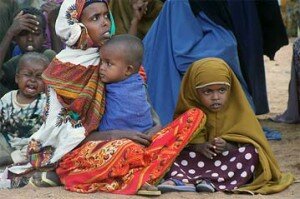
MOGADISHU, SOMALIALarge numbers of Islamist insurgents were reported to be pouring into Somalia’s war-ravaged capital in what appeared to be a bid to pre-empt a much-anticipated offensive against them by the shaky Transitional Federal Government and its allies.
As thousands of civilians fled the Indian Ocean port city, the Islamists of the al-Shebab militia linked to al-Qaida warned neighboring Kenya, which backs the TFG, not to aid the big push the governments says it has been planning.
The Kenyan government in Nairobi has reportedly been recruiting and training a force of some 3,700 Somali emigres to support the TFG’s soldiers, backed by 5,400 African Union peacekeepers and the Ahlu Sunnah Wal-jammah militia.
Insurgent forces were reported to be shelling the presidential palace in Mogadishu, with Ugandan and Burundian troops of the AU peacekeeping force blasting back with heavy artillery.
The AU shelling, as usual, pounded civilian areas and at least 16 people were reported killed by the retaliatory fire.
The peacekeepers’ indiscriminate shellfire has killed hundreds of people over the last 18 months, which has done nothing to bolster the TFG’s popularity.
It was not clear whether al-Shebab fighters were moving against forces backing the TFG or simply seeking to cause havoc to impede the planned government offensive.
The TFG and its allies only control a few blocks of the city around the presidential palace, the airport and the sea port. The rest of the country is ruled by warlords, al-Shebab and other clan-based Islamist militias.
Somalia has been gripped by clan warfare and lawlessness since 1991, when warlords overthrew the dictator Siad Barre.
The size of the al-Shebab force in the capital was not known, but residents reported that jihadist fighters had been moving into Mogadishu from the port of Kismayo 200 miles to the south in recent days.
The TFG has been threatening for weeks to mount a three-pronged offensive against al-Shebab, which controls much of Mogadishu as well as south and central Somalia.
The offensive may bestow some much-needed legitimacy on the TFG administration under its president, Sheik Ahmed Sharif.
It has kept a slender hold on power only though the backing of the United States and the United Nations, and military support from neighboring Ethiopia, which invaded Somalia in December 2006 to oust a short-lived Islamist regime.
The TFG’s forces have long been weak, poorly led and ineffective. But in recent months it has reportedly built up a new force that includes 2,500 Somalis trained by Kenya’s military.
Nairobi denies that. But diplomatic sources say that the Kenyans, who have been hit by Somali-based al-Qaida cells several times over the last decade, have been discreetly doing all they can to undermine the Islamists.
Some of these new troops are reported to have been returning to Somalia in advance of the long-awaited TFG push. But by all accounts, there was little sign of them around Mogadishu as the jihadists launched their new attacks.
The Americans hope that Sheik Ahmed’s offensive will overwhelm al-Shebab, which Washington says is directed by al-Qaida as part of a global jihad.
But the government runs the risk that a new round of major fighting could spread to neighboring states like Kenya as well as Djibouti and Uganda, which Amnesty International says has also been training Somali soldiers and police officers.
Al-Shebab’s deputy commander, Sheik Hussein Abi Gedi, warned on the Islamists’ Andalus radio that his forces were ready to mount a jihad against Kenya.
Given the forces ranged against al-Shebab in Mogadishu and in the south and west, that may be beyond the Islamists’ capabilities right now.
But the Americans say that al-Qaida has been infiltrating senior and mid-level jihadists from Afghanistan and Pakistan to Somalia, as well as crisis-plagued Yemen across the Gulf of Aden, to stir up trouble in the Red Sea region.
Source: Official Wire.



